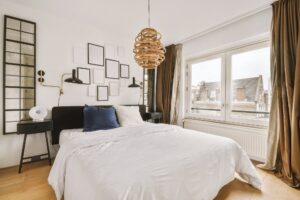Early in the 20th century, the bold and glitzy Art Deco design movement came to be known for its designs. It has greatly influenced interior design and is distinguished by geometric forms, vivid colors, and opulent materials. We’ll look at the origins of Art Deco, what makes it unique, and how you can use it in your own house in this article. The 1920s and 1930s saw a great deal of social & cultural change, which gave rise to art deco. Many artistic movements, such as Futurism, Cubism, and the Bauhaus school, had an impact on it.
Key Takeaways
- Art Deco originated in the 1920s and 1930s, characterized by bold geometric shapes and luxurious materials.
- The style is known for its use of bold colors, such as black, gold, and silver, and incorporating metals, glass, and mirrors.
- Art Deco interior design brings glamour to your home with streamlined furniture, dramatic lighting, and bold accessories.
- Art Deco artwork often features abstract and bold pieces, adding to the overall luxurious feel of the style.
- DIY projects can incorporate Art Deco elements, such as creating a mirrored accent wall or adding geometric patterns to furniture.
The 1925 Parisian Exposition Internationale des Arts Décoratifs et Industriels Modernes, which featured the new aesthetic, is where the term “Art Deco” originated. Bold and geometric shapes, frequently featuring sunburst motifs, chevrons, and zigzags, are what define Art Deco. Along with striking hues and contrasts, it also favors deep jewel tones like ruby red, sapphire blue, & emerald green. Known for its sleek and streamlined designs, the style frequently uses materials like lacquer, glass, & chrome. And last, Art Deco is all about extravagance & luxury, emphasizing materials like marble, exotic woods, & gold accents.
A room can be completely transformed by Art Deco design, which exudes sophistication and glitz. There are various methods to accomplish this look, whether your goal is to design an entire Art Deco-inspired interior or just add a few accent pieces. The famous Chrysler Building in New York City is one example of an interior design influenced by Art Deco.
It is a perfect example of the Art Deco style with its streamlined lines, geometric patterns, & use of opulent materials. The exquisite Art Deco lobby of the Claridge’s Hotel in London, which has marble floors, mirrored walls, & a large chandelier, is another example. The first step in implementing Art Deco in your own house is to select a color palette that captures the opulent and daring essence of the design. For a striking effect, consider using rich jewel tones as your foundation & adding pops of contrasting color.
Consider using vibrant, opulent colors when choosing Art Deco hues. Popular combinations of colors are emerald green and brass, navy blue and silver, and black and gold. Drama & extravagance are created by these pairings, which are essential components of the Art Deco aesthetic. Choose a dominant color for the walls or large furniture pieces before incorporating bold colors into your home.
This might be a rich emerald green or a deep navy blue. Next, use accessories like throw pillows, rugs, and artwork to add splashes of color contrast. For instance, to make a dramatic contrast with a navy blue sofa, add gold throw pillows & a brass coffee table.
In an Art Deco-inspired setting, color coordination is all about achieving a unified aesthetic. Adhere to a small color scheme and apply it uniformly throughout the space. This will bring everything together & establish harmony.
Materials are essential to Art Deco design because they enhance the style and feeling of luxury throughout. Art Deco interiors frequently feature metals like brass, gold, and chrome, which lend a sense of sophistication and glitz. Mirrors and glass are also common in Art Deco architecture, reflecting light & giving the space a feeling of openness. Use metals, glass, and mirrors in furniture, lighting fixtures, and accessories to add these elements to your home. You could pick a mirror with an elaborate gold frame, for instance, or a coffee table with a glass top and a brass frame.
These components will give your room an instant injection of Art Deco elegance. Streamlined & geometric shapes are hallmarks of Art Deco furniture. It frequently has strong angles, slick curves, and clean lines.
Furniture from the Art Deco era frequently uses lacquer, chrome, and exotic woods. Club chairs, angular side tables, and sleek console tables are examples of popular Art Deco furniture. You can add these items to your house to give it a sophisticated and elegant feel.
Seek out furniture with geometric shapes and clean lines, and select materials that accentuate the Art Deco style’s opulence. Because it can bring drama and elegance to a room, lighting is a crucial component of Art Deco design. Often, geometric designs, vivid colors, and opulent materials are seen in Art Deco lighting fixtures. Art Deco interiors often feature chandeliers, wall sconces, and table lamps. Search for lighting fixtures with geometric shapes and vivid colors when selecting Art Deco lighting. Stained glass table lamps or chandeliers with a chrome frame & crystal accents are two options to consider.
In addition to providing useful lighting, these fixtures will make a statement in your Art Deco-inspired interior. Accessories are essential for highlighting the glitzy Art Deco aesthetic. They can bring everything together and give a space the final touches.
Look for accessories with geometric shapes, vivid colors, and opulent materials when selecting accessories with an Art Deco influence. Glass trays, sculptured figurines, and ornamental vases are a few examples of Art Deco accessories. To give your home a hint of Art Deco elegance, place these pieces on shelves, mantels, or coffee tables. To add depth & visual appeal, think about combining various materials and textures together.
Since artwork can give a room personality and character, it is a crucial component of Art Deco design. Bold, abstract designs with an emphasis on geometric shapes and vivid colors are common in Art Deco artwork. Futurism, Abstract Expressionism, and Cubism are popular Art Deco art forms. Look for items that capture the glitzy and audacious essence of the Art Deco movement and combine these styles.
Think about hanging artwork on a wall that receives a lot of attention or making a gallery wall to display several pieces. If you’re feeling ambitious, you can glam up your house with a number of do-it-yourself Art Deco-inspired projects. Depending on your time constraints & skill level, these projects can range from simple to complex. Creating a geometric wall mural, applying metallic paint to vintage furniture, or crafting handmade accessories like decorative vases or mirrored trays are a few examples of Art Deco do-it-yourself projects.
With the help of these projects, you can customize your area & give your Art Deco-inspired interior a special flair. In summary, the Art Deco design movement has had a big influence on interior design. Its striking and glitzy style, which is defined by geometric patterns, vivid colors, and opulent materials, has the power to completely change an area and impart an air of sophistication and elegance. You can create a visually stunning & timeless space in your home by incorporating Art Deco elements.
Thus, why not add a little luxury and embrace the glitz of Art Deco to your own house?
If you’re looking to bring a touch of Art Deco glamour to your home, you’ll want to start with the perfect paint color for your living room. Choosing the right shade can make all the difference in creating a sophisticated and elegant space. To help you in this endeavor, check out this helpful article on how to choose the perfect paint color for your living room from Comely Style. They provide expert tips and advice on selecting colors that will complement the Art Deco style and enhance the overall ambiance of your home. So why wait? Click here to read the article and get started on transforming your living room into a glamorous Art Deco haven.
FAQs
What is Art Deco?
Art Deco is a style of visual arts, architecture, and design that originated in the 1920s and 1930s. It is characterized by its use of geometric shapes, bold colors, and luxurious materials.
How did Art Deco influence home decor?
Art Deco influenced home decor by introducing bold geometric patterns, luxurious materials such as velvet and chrome, and a focus on symmetry and clean lines. It brought glamour and sophistication to home interiors.
What are some Art Deco design elements?
Some Art Deco design elements include geometric shapes, bold colors, metallic finishes, sunburst motifs, stepped forms, and streamlined curves.
What are some ways to incorporate Art Deco into my home?
You can incorporate Art Deco into your home by adding geometric patterned rugs, using metallic finishes on furniture and decor, incorporating sunburst mirrors or clocks, and using bold colors such as black, gold, and silver.
What are some popular Art Deco furniture pieces?
Some popular Art Deco furniture pieces include club chairs, mirrored consoles, chrome and glass coffee tables, and curved sofas.
What are some Art Deco lighting options?
Some Art Deco lighting options include geometric chandeliers, table lamps with bold shades, and sconces with metallic finishes.
What are some Art Deco accessories?
Some Art Deco accessories include sunburst mirrors, geometric vases, chrome and glass bar carts, and bold patterned throw pillows.





